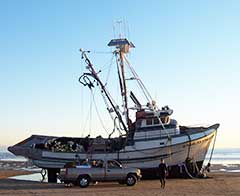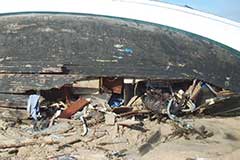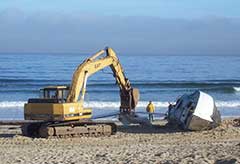Resource Issues: Grounded and Sunken Vessels
 Overview
Overview
Sanctuary personnel respond to an average of 10-12 vessel groundings and sinkings each year. Vessel groundings can crush marine habitat and organisms, release hazardous chemicals, and discharge nets, hooks, and other hazards to marine life.
How is the Sanctuary involved?
Sanctuary staff assess natural resource threats and damage caused by vessel groundings and sinkings and work in concert with government and non-government partners to determine what response actions are appropriate. If not thoughtfully planned and managed, response and cleanup efforts can exacerbate the initial environmental damage caused by a vessel casualty. Therefore, the sanctuary coordinates with other natural resource agencies to ensure that response activities are implemented in an environmentally sound manner, and may even coordinate salvage operations to remove imminent threats to the marine environment. Sanctuary staff also assess environmental damage and promote actions to restore lost and injured natural resources.
Who is responsible?
 If a vessel runs aground or sinks in the sanctuary, the vessel owner is responsible by law for removing the vessel, its fuel, and its contents without causing additional harm to sanctuary resources. For instances where a vessel owner fails to do so, government authorities may take action to remove the threat from the marine environment. In such cases, government agencies typically initiate legal action to recover salvage and response costs from the responsible party. Government agencies may also issue fines and/or file suit against responsible parties for natural resource damages. For example, in 2004 the M/V Med Taipei lost 15 cargo containers within sanctuary waters that resulted in direct impact to the sanctuary. Owners of the Med Taipei were required to pay 3.25 million dollars for a compensatory restoration fund which funds projects such as Studying and Retrieving Lost Fishing Gear, Restoring and Mitigating Seafloor Impacts from Lost Shipping Containers and the Grounded and Sunken Vessel Removal Program. Vessel owners are encouraged to remove grounded and sunken vessels from the sanctuary as promptly and effectively as possible to avoid added environmental injury and increased personal liability.
If a vessel runs aground or sinks in the sanctuary, the vessel owner is responsible by law for removing the vessel, its fuel, and its contents without causing additional harm to sanctuary resources. For instances where a vessel owner fails to do so, government authorities may take action to remove the threat from the marine environment. In such cases, government agencies typically initiate legal action to recover salvage and response costs from the responsible party. Government agencies may also issue fines and/or file suit against responsible parties for natural resource damages. For example, in 2004 the M/V Med Taipei lost 15 cargo containers within sanctuary waters that resulted in direct impact to the sanctuary. Owners of the Med Taipei were required to pay 3.25 million dollars for a compensatory restoration fund which funds projects such as Studying and Retrieving Lost Fishing Gear, Restoring and Mitigating Seafloor Impacts from Lost Shipping Containers and the Grounded and Sunken Vessel Removal Program. Vessel owners are encouraged to remove grounded and sunken vessels from the sanctuary as promptly and effectively as possible to avoid added environmental injury and increased personal liability.
The cost of vessel salvage and natural resource restoration can rise significantly if a wrecked vessel is not promptly removed. The vessel may break up and spread debris and injuries across a larger area, impacting a greater number and variety of wildlife. Hazards from the vessel may spread and impact protected wildlife or damage sensitive habitat. Wrecks also pose threats to people, raising liability for the vessel owner should someone become injured due to the presence of the vessel, hazardous wreckage, or release of toxic substances.
Tips for vessel owners operating within the MBNMS
- Obtain sufficient hull, wreck removal, salvage, and pollution insurance for prompt effective cleanup that avoids or minimizes collateral damage to the marine environment.
- Research area marine salvage companies to determine their capabilities and experience. Salvage capability, pricing, and contracting practices can vary widely. Do your homework and identify professional primary and alternate salvors in advance.
- Know your liabilities under state and federal law in the event of a vessel casualty. There are mandatory reporting requirements and time limits, in addition to owner response requirements.
- Compile comprehensive profile data about your boat (e.g. registration/documentation number, insurance info, contact info, max fuel capacity, weight, schematics, etc.) into a single document for ready access, should an emergency occur.
-
 Assign someone to act as your agent in the event you are involved in a vessel casualty and cannot initiate response action. Make sure they have access to the profile document mentioned above.
Assign someone to act as your agent in the event you are involved in a vessel casualty and cannot initiate response action. Make sure they have access to the profile document mentioned above. - If your vessel becomes a casualty, cooperate fully with response personnel to provide information and resources to remove the vessel quickly and in a manner that avoids or minimizes collateral damage to the marine environment.
- If you sell your boat, ensure that DMV or the Coast Guard has recorded the transfer of title and that official records display the name of the new owner(s).
